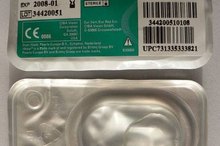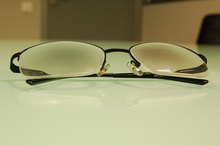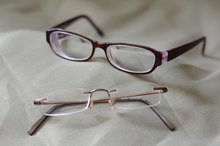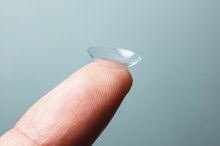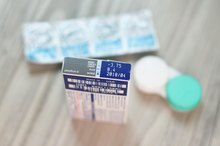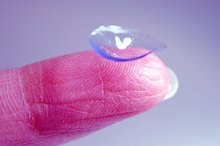According to Refractive Error Source, it is common to have some degree of imperfect vision because light does not focus correctly on most people's retinas. Most vision issues can be corrected with eyeglasses. Every eyeglass prescription has a set of numbers and abbreviations that are used to identify what is needed to correct a person's vision. The numbers tell whether the prescription is made for nearsighted, farsighted, astigmatism, bifocal or other vision corrections, also called refractive errors.
Features
Eyeglass prescriptions are written in a standardized way to prevent confusion and misinterpretation. The prescription for the right eye--written as OD, which is Latin for Oculus Dexte--is always noted first. OS, or Oculus Sinister, is the left eye. Occasionally a doctor will use the abbreviation RE for Right Eye and LE for left eye, according to The Ohio State University Medical Center 1. The prescription for each eye includes numbers indicating sphere, cylinder and axis. It sometimes includes other information such as bifocal power or prism correction.
- Eyeglass prescriptions are written in a standardized way to prevent confusion and misinterpretation.
- Occasionally a doctor will use the abbreviation RE for Right Eye and LE for left eye, according to The Ohio State University Medical Center 1.
Sphere
How to Determine the Base Curve of a Contact Lens
Learn More
An optical prescription notes whether a person is nearsighted--myopic--or farsighted--hyperopic. This number appears under "Sphere" or "SPH" on a prescription and indicates the power of the spectacle lenses. The power refers to diopter, which is a measure of the refractive strength of a lens or of an eye. The Opticianworks website states that sphere powers in ordinary prescriptions are written with the numbers from +/- 0.25 diopters to approximately +/- 15.00 diopters. Prescriptions above the range of +/- 15.00 diopters may require special lenses. Nearsightedness is designated by a negative number, for example -1.00, and farsightedness is written as a positive number. The greater the number, the stronger the prescription and power required to see.
- An optical prescription notes whether a person is nearsighted--myopic--or farsighted--hyperopic.
- The Opticianworks website states that sphere powers in ordinary prescriptions are written with the numbers from +/- 0.25 diopters to approximately +/- 15.00 diopters.
Cylinder
When the clear outer layer of the eye is irregularly shaped, the condition is called astigmatism 2. A perfect cornea is baseball shaped but most corneas tend to be more football-shaped according to the National Eye Institute 2.
Cylinder numbers in a prescription represent the amount of astigmatism. Cylinder powers in ordinary prescriptions range from +/- 0.25 diopters to approximately +/- 5.00 diopters. In this case, a person's prescription would have 0.00 written under Sphere and have numbers under cylinder and axis.
- When the clear outer layer of the eye is irregularly shaped, the condition is called astigmatism 2.
- In this case, a person's prescription would have 0.00 written under Sphere and have numbers under cylinder and axis.
Bifocals
How to Convert Bifocals to Single Vision
Learn More
Eyeglass prescriptions contain a section after sphere, cylinder and axis called "ADD" which stands for "Addition" or additional power. The numbers in this field indicate the bifocal power of a prescription and are always written as a positive number.
Bifocals usually correct for presbyopia, a condition that begins around the age of 40 to 45, according to optometrist Dr. Ted Montgomery. Loss of elasticity of the crystalline lens causes a reduction in the inability to focus clearly up close. This is different than being farsighted and eventually happens to everyone, even if they are nearsighted or farsighted. The higher the ADD number, the more power required to read.
- Eyeglass prescriptions contain a section after sphere, cylinder and axis called "ADD" which stands for "Addition" or additional power.
Prism
Some eyeglass prescriptions include numbers written under the column Prism. This part of the prescription represents a correction for a muscle imbalance in the eye. The Allaboutvision website states that prism is indicated in either metric or fractional English units such as 0.5 or ½, and the direction of the base of prism is indicated by noting it as Base Up or Down (BU or BD) or Base In or Out (BI or BO).
Related Articles
References
- The Ohio State University Medical Center: Eye Glasses and Contact Lenses
- Vimont C, Turburt C. What do astigmatism measurements mean? American Academy of Opthomology. Updated August 31, 2018.
- U.S. National Library of Medicine, MedlinePlus. Presbyopia. Reviewed March 6, 2018.
- Porter D. What is prism correction in eyeglasses? American Academy of Opthomology. Reviewed February 6, 2019.
- Eskridge, J. Boyd, John Amos and Jimmy D. Bartlett. "Clinical Procedures In Optometry." Copyright 1991 by J.B. Lippincott Company, Chapter 18 - "Monocular Subjective Refraction" by Polasky Michael, pp 174-188.
Resources
Writer Bio
Beth Richards, a freelance writer since 2002, writes about health and draws from her 25 years as a licensed dispensing optician. She has authored several books, writes for national magazines including "Country Living" and "Organic Family" and is a health and wellness features writer for several publications. She is earning a Bachelor of Arts in English from the University of Maryland.
